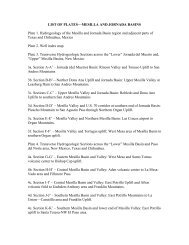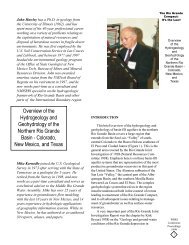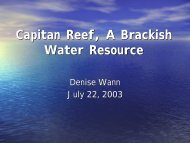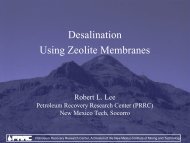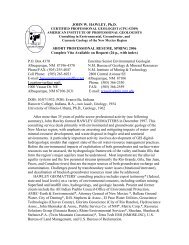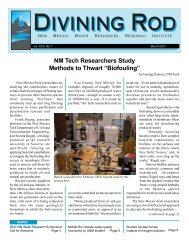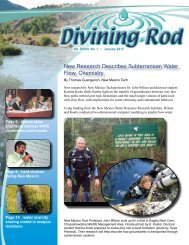more practical. When saltwater is frozen, the salt ions sink to the bottom over time, leavingfreshwater at the top that may be melted or shaved <strong>of</strong>f [2].The newest commercial technology for desalination is based on membrane treatment. Brackish<strong>Water</strong> <strong>Reverse</strong> <strong>Osmosis</strong> (BWRO), or Sea <strong>Water</strong> <strong>Reverse</strong> <strong>Osmosis</strong> (SWRO), is the fastestgrowing desalination technique with the greatest number <strong>of</strong> installations around the globe; it isbeginning to dominate the current <strong>and</strong> future desalination markets. Its energy consumption isusually some 70% less than for comparable evaporation technologies [2]. Advancements havebeen made in membrane technology, resulting in stable, long-lived membrane elements.Component parts have been improved, as well, reducing maintenance <strong>and</strong> down time. Additionaladvancements in pretreatment have been made in recent years, further extending membrane life<strong>and</strong> improving performance. <strong>Reverse</strong> osmosis delivers product water or permeate havingessentially the same temperature as the raw water source (an increase <strong>of</strong> 1 O C or 1.8 O F may occurdue to pumping <strong>and</strong> friction in the piping). This is more desirable than the hot water produced byevaporation technologies. RO systems can be designed to deliver virtually any required productwater quality. For these <strong>and</strong> other reasons, RO is usually the preferred method <strong>of</strong> desalinationtoday [3].A disadvantage <strong>of</strong> RO is the need for significant pre-conditioning <strong>of</strong> the feed water to protect themembranes. The extent <strong>of</strong> pre-treatment requirements depends on a variety <strong>of</strong> factors, such asseawater composition <strong>and</strong> temperature, seawater intake, membrane materials, <strong>and</strong> recovery ratio.Typical electricity consumption <strong>of</strong> SWRO plants is in the range <strong>of</strong> 4 to 7 kWh/m 3 , depending onseawater salinity, recovery ratio, required permeate quality, plant configuration, <strong>and</strong> energyrecovery in the brine blowdown [3].Southern Iraq has been ruined by millennia <strong>of</strong> poorly engineered irrigation. The ground water inthe south <strong>of</strong> Iraq is almost as saline as sea water, at 30,000 ppm. A water shortage described asthe most critical since the earliest days <strong>of</strong> Iraq's civilization is threatening to leave up to 2 millionpeople in the south <strong>of</strong> the country without electricity <strong>and</strong> almost as many without drinking water[4]. Therefore, there is an actual need <strong>of</strong> water desalination in this part <strong>of</strong> Iraq.In this paper, we consider a medium-capacity RO desalination plant with a capacity <strong>of</strong> 2,000m 3 /day used to supply water for the people living in Umm Qasr, located at 30 o .01’ N latitude <strong>and</strong>47 o 57’E longitude, which is a small port city in southern Iraq, on the western side <strong>of</strong> the al-Fawpeninsula. We analyze this plant using the desalination economic evaluation program DEEP-3.2created by the International Atomic Energy Agency [5].2. <strong>Reverse</strong> <strong>Osmosis</strong> (RO) system<strong>Reverse</strong> osmosis is a membrane separation process in which pure water passes from the highpressureseawater side <strong>of</strong> a semipermeable membrane to the low-pressure permeate side <strong>of</strong> themembrane. To overcome the natural osmotic process, the seawater side <strong>of</strong> the system has to bepressurized to create a sufficiently high net driving pressure across the membrane. In practice,the seawater can be pressurized to pressures as high as 70 to 80 bars. The remaining feed watercontinues through the pressurized side <strong>of</strong> the unit as brine. No heating or phase change takesplace [2].
2.1 RO system componentsThe two most basic individual components in a seawater RO system are the high-pressure feedpump <strong>and</strong> the RO membranes. These components comprise the heart <strong>of</strong> any RO system <strong>and</strong>require careful selection <strong>and</strong> application for successful operation. In addition to these, othercomponents related to the pretreatment <strong>of</strong> the inlet water <strong>and</strong> adjustment <strong>of</strong> the product water arealso included. As shown in Figure 1, an RO system consists <strong>of</strong> four major components/processes[6]:Pretreatment. The incoming feed water is pretreated to be compatible with the membranesby removing suspended solids, adjusting the pH, <strong>and</strong> adding a threshold inhibitor to controlscaling caused by constituents such as calcium sulfate.Pressurization. The pump raises the pressure <strong>of</strong> the pretreated feed water to an operatingpressure appropriate for the membrane <strong>and</strong> the salinity <strong>of</strong> the feed water.Separation. The permeable membranes inhibit the passage <strong>of</strong> dissolved salts whilepermitting the desalinated product water to pass through. The saline feed is pumped into aclosed vessel where it is pressurized against the membrane. As a portion <strong>of</strong> the water passesthrough the membrane, the salt content in the remaining brine increases. At the same time, aportion <strong>of</strong> this brine is discharged without passing through the membrane.Stabilization. The product water from the membrane assembly usually requires pHadjustment <strong>and</strong> degasification before being transferred to the distribution system for use asdrinking water. The product passes through an aeration column in which the pH is elevatedfrom a value <strong>of</strong> about 5 to close to 7. In many cases, this water is discharged to a storagecistern for later use.Figure 1. Schematic diagram <strong>of</strong> an RO system.2.2 RO membrane configuration <strong>and</strong> materialsRO membranes come in a variety <strong>of</strong> configurations. Two <strong>of</strong> the commercially successfulconfigurations are the spiral-wound module <strong>and</strong> hollow-fiber module [7]. In both configurations,module elements are serially connected in pressure vessels (up to seven in spiral-wound modules<strong>and</strong> up to two in hollow-fiber modules).Spiral-Wound moduleA spiral-wound module element consists <strong>of</strong> two membrane sheets supported by a grooved orporous support sheet. The support sheet provides the pressure support for the membrane sheets,as well as providing the flow path for the product water. Each sheet is sealed along three <strong>of</strong> itsedges, <strong>and</strong> the fourth edge is attached to a central product discharge tube. A plastic spacer sheet



